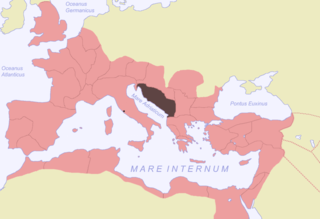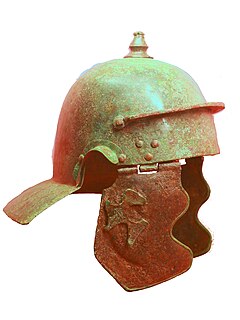| Cohors II Alpinorum equitata | |
|---|---|
 Roman infantry helmet (late 1st century) | |
| Active | early 1st century to at least early 3rd century |
| Country | Roman Empire |
| Type | Roman auxiliary cohort |
| Role | infantry/cavalry |
| Size | 600 men (480 infantry, 120 cavalry) |
| Garrison/HQ | 60 Illyricum; 84-223 Pannonia Superior |
Cohors secunda Alpinorum equitata ("2nd part-mounted Cohort of Alpini") was a Roman auxiliary (non-citizen) mixed infantry and cavalry regiment. Alpini was a generic name denoting several Celtic-speaking mountain tribes inhabiting the Alps between Italy and Gaul, which were organised as the Tres Alpes provinces.

The Alps are the highest and most extensive mountain range system that lies entirely in Europe, separating Southern from Central and Western Europe and stretching approximately 1,200 kilometres (750 mi) across eight Alpine countries : France, Switzerland, Italy, Monaco, Liechtenstein, Austria, Germany, and Slovenia. The mountains were formed over tens of millions of years as the African and Eurasian tectonic plates collided. Extreme shortening caused by the event resulted in marine sedimentary rocks rising by thrusting and folding into high mountain peaks such as Mont Blanc and the Matterhorn. Mont Blanc spans the French–Italian border, and at 4,810 m (15,781 ft) is the highest mountain in the Alps. The Alpine region area contains about a hundred peaks higher than 4,000 metres (13,000 ft).

Gaul was a historical region of Western Europe during the Iron Age that was inhabited by Celtic tribes, encompassing present day France, Luxembourg, Belgium, most of Switzerland, parts of Northern Italy, as well as the parts of the Netherlands and Germany on the west bank of the Rhine. It covered an area of 494,000 km2 (191,000 sq mi). According to the testimony of Julius Caesar, Gaul was divided into three parts: Gallia Celtica, Belgica, and Aquitania. Archaeologically, the Gauls were bearers of the La Tène culture, which extended across all of Gaul, as well as east to Raetia, Noricum, Pannonia, and southwestern Germania during the 5th to 1st centuries BC. During the 2nd and 1st centuries BC, Gaul fell under Roman rule: Gallia Cisalpina was conquered in 203 BC and Gallia Narbonensis in 123 BC. Gaul was invaded after 120 BC by the Cimbri and the Teutons, who were in turn defeated by the Romans by 103 BC. Julius Caesar finally subdued the remaining parts of Gaul in his campaigns of 58 to 51 BC.

Tres Alpes, was the collective term used by the Romans to denote three small provinces of the Roman empire situated in the western Alps mountain range, namely Alpes Graiae ; Alpes Cottiae and Alpes Maritimae. The region was annexed by the Romans in 16 - 14 BC and the three provinces organised by 7 BC.
Contents
The regiment was probably raised as one of 4-6 Alpini units recruited after the final annexation of the western Alpine regions by emperor Augustus in 15 BC. [1] It first appears in the datable epigraphic record in Illyricum in 60 AD. Not later than 84 it was stationed in Pannonia, though inscriptions at Colonia Agrippina (Cologne) in Germania Inferior suggest that it had a brief sojourn there in between Illyricum and Pannonia. In c. 107, when Pannonia was split in two, the regiment remained in Pannonia Superior. It was still in that province at the time of its last datable inscription (223-35). The regiment's inscriptions have been found at the following Roman forts (in likely order of occupation): Mursa; Colonia Agrippina (Germania); Baratsföldpuszta; Dunaubogdány (185 and 223). [2]

Augustus was a Roman statesman and military leader who was the first emperor of the Roman Empire, reigning from 27 BC until his death in AD 14. His status as the founder of the Roman Principate has consolidated an enduring legacy as one of the most effective and controversial leaders in human history. The reign of Augustus initiated an era of relative peace known as the Pax Romana. The Roman world was largely free from large-scale conflict for more than two centuries, despite continuous wars of imperial expansion on the Empire's frontiers and the year-long civil war known as the "Year of the Four Emperors" over the imperial succession.

Illyricum was a Roman province that existed from 27 BC to sometime during the reign of Vespasian. The province comprised Illyria/Dalmatia and Pannonia. Illyria included the area along the east coast of the Adriatic Sea and its inland mountains. With the creation of this province it came to be called Dalmatia. It was in the south, while Pannonia was in the north. Illyria/Dalmatia stretched from the River Drin to Istria (Croatia) and the River Sava in the north. The area roughly corresponded to modern northern Albania, Montenegro, Bosnia and Herzegovina and coastal Croatia. Pannonia was the plain which lies to its north, from the mountains of Illyria/Dalmatia to the westward bend of the River Danube, and included modern Vojvodina, northern Croatia and western Hungary. As the province developed, Salona became its capital.

Pannonia was a province of the Roman Empire bounded north and east by the Danube, coterminous westward with Noricum and upper Italy, and southward with Dalmatia and upper Moesia. Pannonia was located over the territory of the present-day western Hungary, eastern Austria, northern Croatia, north-western Serbia, northern Slovenia, western Slovakia and northern Bosnia and Herzegovina.
The names of 3 praefecti (regimental commanders) are preserved. Only one has a certain origin, Aulus Plautius Bassianus from the city of Rome. A vexillarius (regimental standard-bearer) is recorded as of the Dalmatae Illyrian tribe and a tubicen (trumpeter) of unknown origin. The names of 5 caligati (common soldiers) are extant, all of unknown origin. [2]

The Dalmatae or Delmatae were an ancient people who inhabited the core of what would then become known as Dalmatia after the Roman conquest at the eastern Adriatic coast, in what is present-day Croatia and Bosnia and Herzegovina, between the rivers Krka, on the northwest, the Neretva on the east, and the river Rama on the northeast. The Delmatae are mostly classed as an Illyrian tribe.

The Illyrians were a group of Indo-European tribes in antiquity, who inhabited part of the western Balkans. The territory the Illyrians inhabited came to be known as Illyria to Greek and Roman authors, who identified a territory that corresponds to Croatia, Bosnia and Herzegovina, Slovenia, Montenegro, part of Serbia and most of central and northern Albania, between the Adriatic Sea in the west, the Drava river in the north, the Morava river in the east and the mouth of the Aoos river in the south. The first account of Illyrian peoples comes from the Periplus of Pseudo-Scylax, an ancient Greek text of the middle of the 4th century BC that describes coastal passages in the Mediterranean.


